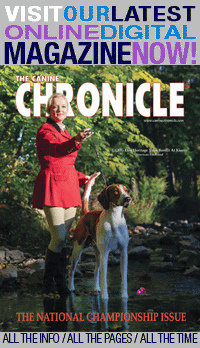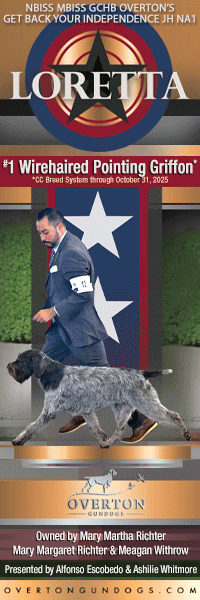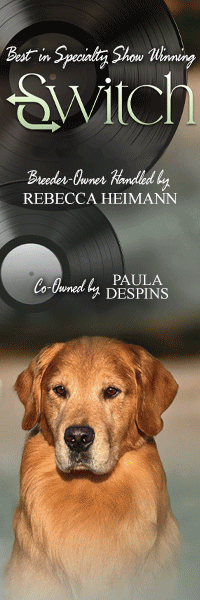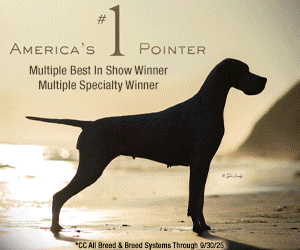The Shetland Sheepdog
Click here to read the complete article
by Amy Fernandez
 A few standout breeds perpetually grab the limelight, then there are the outliers, renegades, and newcomers. But most fall into the category of reliable, steady contenders. Every once in awhile they launch a mainstream star, but overall they basically keep the faith without making waves. Shelties were considered part of that majority throughout their tenure in the Working Group from 1911 until 1983 and after their subsequent reassignment to Herding.
A few standout breeds perpetually grab the limelight, then there are the outliers, renegades, and newcomers. But most fall into the category of reliable, steady contenders. Every once in awhile they launch a mainstream star, but overall they basically keep the faith without making waves. Shelties were considered part of that majority throughout their tenure in the Working Group from 1911 until 1983 and after their subsequent reassignment to Herding.
Therefore, the dog world’s collective astonishment was understandable last June when the Sheltie world erupted into a firestorm following breed judging at the Southern Counties championship show in England. After all, the breed hails from Shetland where the mantra has always been to shut up and get on with life.
For most of the world Shetland is all about those charming, tiny animals. Best known is the Shetland pony, topping out at 10.2 hands (42 inches). Shetland’s workhorse was one of many native species honed by geographic isolation, harsh conditions, and scarce resources. Its domesticated livestock is uniformly small, thrifty, adaptable, slow growing, and pound-for-pound tough as nails. That wasn’t optional. Along with strength, endurance, and hardiness they are equipped with primitive survival instincts rarely encountered in domestic animals.
Since the ninth century, its hardy, nimble, pint-sized sheep have produced the fine, silky wool that made Shetland knitwear the island’s most lucrative trade commodity. Those knitting needles never stopped. Right around the time that Queen Victoria redoubled worldwide demand for those fine, delicate, handmade lace stockings and shawls, Shetland’s women probably sighed in relief because a new product appeared on the island’s economic radar.
Like everything else on Shetland, the dogs perpetuated to tend those sheep were purposebuilt; designed to be compact, reliable, resilient, and fuel efficient. They didn’t need to be pretty, at least until their distinctive bantam size became a marketable feature. The revolution began, “when fashion demanded that these dogs be bred smaller for pets, alien blood was introduced”. ASSA founding member Catherine Coleman established her Sheltieland Kennel in 1924. She authored the breed’s first definitive history in 1943, and mentored generations of influential breeders. From her standpoint, commercializing Shetland’s homegrown breed amounted to sacrilege. However, Shetland wasn’t a land of easy opportunity. Shetland women didn’t earn their world class reputation for speed knitting because it was fun. If British dog lovers hankered for their little dogs, no one was in a financial position to argue the point.
Shetlanders began crossing their stock to Toy breeds in response to this burgeoning pet market. She said, “It was ludicrous to assert that the dogs were of pure lineage when many had Pomeranian stamped all over them.” According to Coleman the resulting six to ten pound dogs resembled Papillon, Pom, or early versions of Longcoat Chihuahua, then euphemistically known as Mexican Toy Shepherds. “Shetland Sheepdogs sent down from the Islands in the beginning were very uneven in type but did possess plenty of stamina and great muscular development for their size.” As Coleman noted, repackaging the Sheltie as a Toy didn’t alter its original, tough working dog recipe. The problem was that no one really knew precisely what had gone into that mix.
In his 1947 book, Working Dogs of the World, Clifford Hubbard called them a, “heterogeneously bred colony of little dogs…Known as the Tounie Dog or Peerie Dog throughout the Outer Hebrides, the Orkneys, and to the west as far as St. Kildas.” He theorized that the Sheltie evolved from an ancient hodgepodge of farm dogs brought to this isolated North Sea outpost from Scandinavia, Denmark, Holland and mainland Scotland.
Coleman cited a 1906 article detailing the bewildering assortment of physical traits manifested in Shetland’s indigenous breed. Proportion, leg length, and head type varied in every respect. Ears ranged from small, erect and close set to large, low set, and flaring, some “like great fluffy wings.” High and low set tails were long, short, or curled over the back. All these interesting variations were packaged in coats from short and dense to long, straight, and silky, sometimes curly, and most commonly half-long and soft-textured. Needless to say, every conceivable color combination was represented. The introduction of Toy breeds spiced up the gene pool, but it was freestyle long before that.
Lacking other unifying physical traits, size became the Sheltie’s identity card. That trait launched it into the purebred orbit, but it wasn’t the only powerful undercurrent destined to impact its development. Admittedly, the Collie had contributed to the Sheltie gene pool back when no one kept score and a portion of the population reflected that fact. However, Collie type most definitely was not the Sheltie keynote at that point.
Crossing to an established breed is a proven method to consolidate type and the systematic introduction of small Collies reportedly commenced soon after the first Shelties arrived in Britain. There was a rational argument for this approach based on the Sheltie’s original job. However, a more plausible explanation according to Coleman was the fact that many Shelties “possessed points which blended well with those of the Collie….The dogs varied considerably in size from 13-16 inches but showed a certain uniformity of type and build, being sturdy and upstanding dogs which gave promise of both speed and endurance.”
More significantly, by pirating Collie type, Sheltie promoters instantly tapped into the era’s most powerful dog fad. By the time the Sheltie debuted as a show dog at Crufts in 1906, Collie-mania was in overdrive. “So successful were these early attempts at improving them through a Collie outcross that within a relatively short space of time the Peerie Dog became more generally known as the Shetland Collie…and the newly improved race grew in strength”. This “less mongrelized edition” as Hubbard called them, was soon riding that wave of Collie popularity. He said, “That year people were beginning to talk of the breed, Scottish shows were offering classes and within a short time the Sheltie spread to England.” Almost overnight, this obscure rustic breed became front page news.
Coleman goes on to say that “breeding operations were being conducted extensively to supply the demand which was so great in Great Britain that it was difficult to secure a good one.” Unfortunately, everyone had different ideas about what constituted “a good one”. Size remained a volatile issue but it was far from the only one complicating Sheltie development. And every single one worsened exponentially as the breed gained traction. A year after Kennel Club recognition in 1909, Sheltie classes at Crufts were well-supported by both Scottish and English exhibitors–all of them marching to their own tune of correct breed type.
 Naturally, a substantial contingent of fanciers–both inside and outside the breed–objected to labeling the Sheltie as a Collie knockoff. As Coleman noted, kennels based on Shetland Island imports were never comfortable with those implications. “Older kennels which possessed imported Island stock and their offspring held out for what they considered the old original type.” Needless to say, the Collie power bloc also took exception to this unauthorized appropriation, eventually forcing a revision of the breed’s official name to Sheepdog. Hubbard described the paradoxical outcome of this dustup by writing, “One thing emerged from this quarrel which was almost an international affair, however, and that was the publicity which attended it gave the new race such an impetus, whereas had there not been the clash over its nomenclature it would probably be unknown outside the Shetland Isles.”
Naturally, a substantial contingent of fanciers–both inside and outside the breed–objected to labeling the Sheltie as a Collie knockoff. As Coleman noted, kennels based on Shetland Island imports were never comfortable with those implications. “Older kennels which possessed imported Island stock and their offspring held out for what they considered the old original type.” Needless to say, the Collie power bloc also took exception to this unauthorized appropriation, eventually forcing a revision of the breed’s official name to Sheepdog. Hubbard described the paradoxical outcome of this dustup by writing, “One thing emerged from this quarrel which was almost an international affair, however, and that was the publicity which attended it gave the new race such an impetus, whereas had there not been the clash over its nomenclature it would probably be unknown outside the Shetland Isles.”
The name changed, but that Collie agenda remained on the table even though it became increasingly complicated. By then, Collie popularity had achieved sufficient velocity to spawn a treasure chest of fads and extreme types. Coleman said, “If modern Collies did not fulfill their standard description sufficiently to make them desirable as Sheltie models, it was because they passed through a period of overemphasis on certain points in their attempt to attain that ideal”. Coleman conceded that “Collie type” became an increasingly subjective concept. By the 1920s, the “show” Collie and the “working” Collie stood at opposite ends of a widening spectrum of weirdness. Inevitably the growing scale of Collie x Sheltie crossbreeding then being conducted (both on and off the record) ensured that all these interesting innovations seeped into the Sheltie gene pool. Along with every controversial color and head style, the Smooth Sheltie soon made its debut.
There was plenty of valid opposition to that Collie scheme and it was easy to assert that the Sheltie had no business in that part of town. The tricky part was devising a viable, alternative plan. No one had a solution. However, there was no shortage of opinions like this snippet from Our Dogs editor Theo Marples, “Bred on the Islands indiscriminately, the original specimens of Shetland Sheepdog were, and are, naturally of a somewhat nondescript pattern. The only con-sideration which the Shetland farmers had originally in mating their bitches was to produce working qualities. …that is why I can never understand the force of those who argue that the Shetland Sheepdog should be kept to his original type, which is really no type at all.”
Britain’s first Sheltie club, founded in Shetland in 1908, issued a standard describing the breed as “A Collie in miniature” with a height disqualification of 15 inches. A year later the Scottish breed club emerged with a standard describing the breed an “ordinary Collie in miniature” –miniature being ideally 12 inches. Their version was later amended to “modern show collie in miniature” with an ideal height of 13½ inches. These weren’t the only groups contributing official recommendations.
Standards are blueprints for an ideal type. They are also treacherous prop-ositions. Concisely worded and well-intentioned, they frequently invite a quagmire of unanticipated reper-cussions, as Coleman confirmed. “Although the standard paints a pretty definite word picture of what is wanted in the Shetland Sheepdog, the difficulty of attaining this ideal, and of interpreting the standard in terms of desired type, precipitated a first class crisis for the breed…,” she wrote.
Breed progress is impossible if the requirements of its standard are realistically unattainable. The Sheltie fancy wasn’t the first determined group to stumble on that shocking fact. Demanding that ostensible “Collie type” within that size range was pure fantasy at that stage of the game, “They concluded that to maintain twelve inches and at the same time keep Collie type and character failed to agree in practices if they did in theory”. As Coleman put it, the choice came down to breeding for ideal size at the expense of type or producing oversized dogs with recognizable type. The fallout of this conundrum eventually coalesced into two opposing camps. “New exhibitors were confused by the two types and their variations and older fanciers distressed by the tendency to sacrifice all essential Collie characteristics to size,” she wrote.
Size reduction is a pretty straightforward process and theoretically, a few generations of strict, selective breeding could have created a miniature version within the Collie gene pool, but that’s not a Sheltie. Noting some of the distinctive differences in balance, proportion, foot shape, skull, muzzle, and expression, Coleman emphasized the Sheltie’s most crucial defining trait. Along with its unshakable stamina and working drive, “It was its character”.
The Sheltie world was no happy family at that point. It was hard to see the big picture from the front lines of that combat zone, but all those warring factions were fighting for the same cause – preserving those nuances of type that made the Sheltie a distinct breed. They also had drastically different ideas about how to manage that feat. However, as Coleman confirmed, “Not until the first declared Collie cross was marked improvement made in the breed.” The participants were Wallace, who she described as the “best typed small dog of the day” and Teena, a small golden sable Collie. “The dogs were largely linebred to Teena and carried tremendous coats and distinct Collie type,” she wrote. They contributed to the foundation of several important strains including Eltham Park, Peabody, and Chestnut.
That painstaking crossbreed-ing/inbreeding formula has been successfully utilized to create and stabilize type in countless breeds. It also proved to be the key to resolving this snarly mess. Breeders employed variations of this strategy, mixing 5 to 22 percent Collie into Sheltie breeding programs. Within that framework, key traits were perpetuated, traces of Pom and Spaniel slowly diminished, and the Sheltie began to emerge.
While all this drama unfolded, the Sheltie hit America’s radar. Predictably, AKC followed the Kennel Club’s lead, recognizing the breed in 1911. That year, Dogdom Monthly, the touchstone of trends and news in the American fancy announced the arrival of AKC’s “new Toy breed” which illustrated the baffling state of Sheltie affairs at that point.
Both genetically and philosophically, American fanciers were a step removed from Britain’s escalating debates about the finer points of type, which made it easier to stay out of the crossfire for awhile at least. But as Coleman noted, “repercussions of the controversy were felt on both sides of the water”. Dogs were imported, foundation breeding programs established, and the breed gained ground. American breeders never encountered the festival of varying types that British breeders grappled with but that dreadful size issue came into laser focus. Most imports comprising American foundation stock derived from first or second generation Collie crosses. When they were interbred, that 13-inch ideal was a far cry from what arrived in whelping boxes. According to Coleman, two-thirds of the first AKC champions were 15 inches and up. Quite a few topped out at 18 inches.
Genetically, size reduction is a package deal. Maintaining proper bone, substance, proportion, and head type within limited size parameters qualifies as a genuine selective breeding challenge. At times, the job must have seemed insurmountable. In reality, it took about 30 years. And despite the Sheltie fancy’s penchant for internecine warfare, much of the progress resulted from the remarkable support and cooperation between British and American kennels.
Among those breakthrough bloodlines were the legendary Scottish kennels of the Saunders brothers James (Helensdale) and William (Farburn). Both lines traced back to the famous Teena. Their breeding pro-duced several crucial American imports such as Ch. Farburn Captain and Eng./ Am. Ch. Rob Roy of Page’s Hill, profiled in the 1938 AKC Blue Book of Dogs. It said, “Back in 1934 Mr. William W. Gallagher of Need-ham, Massachussetts found himself on the banks of the Silvery Dee in Scotland with his longtime friend James Saunders president of the Scottish Shetland Sheepdog Association in Aberdeen.” Gallagher selected a dog pup, registered him as Rob Roy of Page’s Hill, and left him with Saunders who finished him in three shows before sending him to America. The report continued, “The following fall he was in the hands of Nate Levine who put him through his American championship undefeated.”
Gallagher and Levine were among the most influential players in American Shelties during that pivotal era. Rob Roy was one of several significant dogs they imported and campaigned. “Mr. Gallagher and his loyal friend Nate Levine have stood shoulder to shoulder through good and bad Sheltie times since Mr. Gallagher first started to show this clever charming breed. Mr. Gallagher notes that Shelties have improved tre-mendously within the past five years. There was a time when different types and styles came into the ring, now they are very uniform and very good…It is Mr. Gallagher’s opinion that today’s Shelties are more nearly the true Collie type,” it was reported.
Levine was instrumental in founding the ASSA and both men served terms as club president. Most importantly, they were staunch, outspoken proponents of Collie type. As Levine’s 1968 essay for the ASSA Yearbook confirmed 30 years down the road, his opinion hadn’t mellowed a bit. He wrote, “When the founding fathers of the breed found their Shelties lacking ideal Collie type, they crossed their dogs with Collies to establish the desired type…Not only does our standard carefully and in minute detail describe the desired characteristics (especially in regard to head qualities) it does, in its opening paragraph clearly refer to another well-known breed, the Rough Collie. How then, one wonders, have we arrived at the type of Sheltie one sees in the kennel and show ring today?”
Specifically, he took aim at the writing, “rings full of well-marked, well-coated, beautifully conditioned, well-presented dogs lacking correct head type…True that there are fewer really terrible Pomeranian heads to be seen today. But are masses of mediocre dogs really a good substitute for a few really great ones we saw in the ‘40s and ‘50s? …you must make the choice whether to select stud dogs lacking faults and settle for mediocrity, or select on the basis of positive virtues with a chance of getting that great one. And what is that great one?”
 Topping Levine’s list of great ones was Gallagher’s Ch. Windrush o’Page’s Hill, whose headstudy appeared on the cover of the ASSA standard. Handled by Nate Levine, in 1943 Windrush became the only Sheltie to win a Westminster Working group. As Arthur Fredrick Jones confirmed in his subsequent AKC Gazette report it was no easy victory. He wrote, “chief challenger of the Sheltie was the Great Dane Ch. Olgo of Brae Tarn, third went to John Wagner’s Boxer Ch. Volante of Mazelaine, and fourth to the Newfoundland Ch. Waseeka Smuggler.” That wasn’t the only Sheltie triumph at Westminster’s 67th show. Jones continued, “the naming of the Shetland Sheepdogs as best team established a record, for this was the fourth time in succession that Miss Elizabeth Whelan of Fairview Village, PA had gone to the top with her small working dogs.”
Topping Levine’s list of great ones was Gallagher’s Ch. Windrush o’Page’s Hill, whose headstudy appeared on the cover of the ASSA standard. Handled by Nate Levine, in 1943 Windrush became the only Sheltie to win a Westminster Working group. As Arthur Fredrick Jones confirmed in his subsequent AKC Gazette report it was no easy victory. He wrote, “chief challenger of the Sheltie was the Great Dane Ch. Olgo of Brae Tarn, third went to John Wagner’s Boxer Ch. Volante of Mazelaine, and fourth to the Newfoundland Ch. Waseeka Smuggler.” That wasn’t the only Sheltie triumph at Westminster’s 67th show. Jones continued, “the naming of the Shetland Sheepdogs as best team established a record, for this was the fourth time in succession that Miss Elizabeth Whelan of Fairview Village, PA had gone to the top with her small working dogs.”
That signaled the point in Sheltie history when the tide began turning in its favor. Two decades later, Ch. Elf Dale Viking vaulted into the top ten in 1963, becoming one of the biggest winners in Sheltie history.
Currently Shelties rank 21st among AKC registered breeds and consistently rack up accomplishments in dog sports across the board.
The breed’s current success makes it easy to forget the long, hard struggle that accompanied Sheltie evolution. Those vicious battles, bitter feuds, and endless standard revisions are ancient history. However, they are not entirely forgotten. The recent uproar at Southern Counties cut to core of philosophical perceptions of Sheltie type and reignited longstanding differences that had simmered since the breed’s earliest forays into purebred competition.
Coleman lived through that contentious era. She said, “All breeders were actually working towards that goal no matter how much their means and methods differed and ultimately would attain that goal by working with nature not against her, to bring size down gradually and at the same time retain the Collie type and Sheltie disposition.”
Although she was writing in 1943, her insights are equally relevant today.
Short URL: https://caninechronicle.com/?p=93402
Comments are closed











